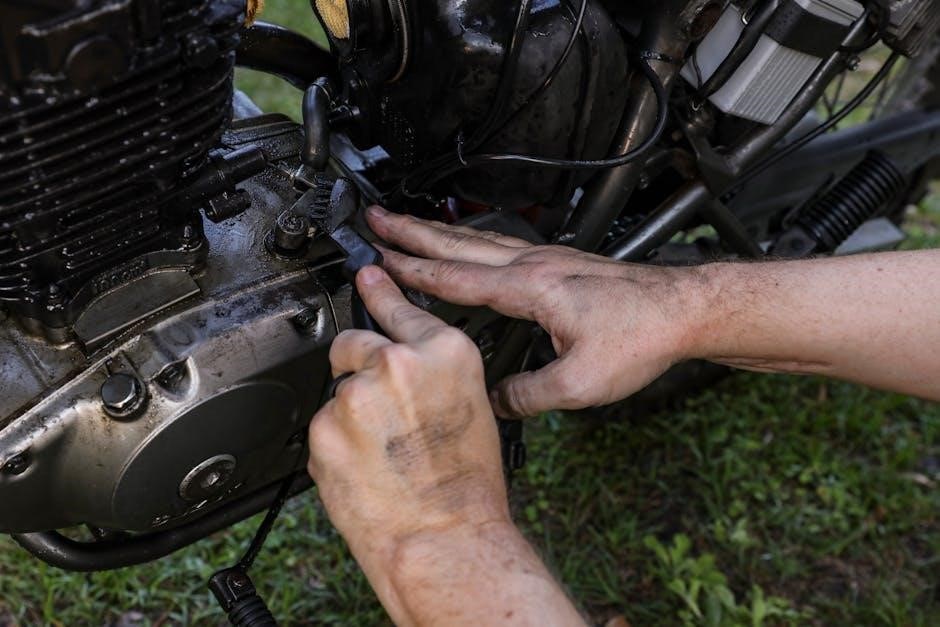
motorcycle mechanic manual
Motorcycle Mechanic Manual: A Comprehensive Guide
A motorcycle mechanic manual is your essential companion for repairs and maintenance. Whether you’re a seasoned mechanic or a DIY enthusiast, these manuals provide detailed guidance. They cover everything from basic servicing to complex engine overhauls, ensuring your bike stays roadworthy.
Motorcycle repair manuals are indispensable tools for both professional mechanics and motorcycle owners who prefer to perform their own maintenance and repairs. These manuals offer comprehensive information, including step-by-step instructions, detailed diagrams, and troubleshooting guides, empowering users to tackle a wide range of tasks. From routine servicing like oil changes and brake maintenance to more complex procedures such as engine disassembly and reassembly, a good repair manual provides the necessary knowledge and guidance. They help save time and money, ensure correct procedures, and ultimately keep your motorcycle in optimal condition, promoting safety and longevity.
Types of Motorcycle Manuals
Motorcycle manuals come in various forms. OEM manuals offer manufacturer-specific information. Aftermarket manuals, like Haynes and Clymer, provide broad coverage. Digital manuals offer convenience, while printed versions are reliable in the shop.
OEM (Original Equipment Manufacturer) Manuals
OEM manuals, supplied by the motorcycle manufacturer, are the gold standard for accuracy and detail. These manuals offer specific information related to your bike’s year, make, and model. Containing detailed diagrams, specifications, and procedures, they give insight into the original design and engineering of your motorcycle. They are great for complex repairs or restoration projects where adherence to the original factory specifications is important. While often pricier and less readily available than aftermarket options, the peace of mind they provide is invaluable for serious motorcycle enthusiasts and professional mechanics seeking unparalleled accuracy.
Aftermarket Manuals (Haynes, Clymer, Cyclepedia)
Aftermarket manuals from publishers like Haynes, Clymer, and Cyclepedia offer a cost-effective alternative to OEM manuals. These manuals cover a range of models and years, providing broad applicability. They are known for their step-by-step instructions, photos, and illustrations, making them user-friendly for DIY mechanics; These manuals often include troubleshooting sections to diagnose common issues. Cyclepedia manuals often boast online access and tech support, enhancing their value. While not as model-specific as OEM manuals, they provide sufficient detail for most maintenance and repair tasks. They are a practical choice for everyday use and general motorcycle upkeep.

Key Sections in a Motorcycle Repair Manual
Motorcycle repair manuals contain crucial sections like troubleshooting guides, wiring diagrams, and engine repair overviews. These sections help diagnose problems, understand electrical systems, and perform engine maintenance, making them essential for any motorcycle work.
Troubleshooting Guides
Troubleshooting guides are a pivotal section within motorcycle repair manuals, designed to aid in diagnosing common issues. They typically present a systematic approach, starting with symptom identification and leading to potential causes. These guides often include flowcharts, diagnostic tables, and step-by-step instructions to pinpoint the source of the problem. By consulting the troubleshooting section, mechanics and DIY enthusiasts can efficiently resolve issues related to the engine, electrical system, brakes, or other components. This saves time and ensures accurate repairs, reducing the risk of further damage to the motorcycle.
Wiring Diagrams
Wiring diagrams are an indispensable part of any comprehensive motorcycle repair manual, offering a detailed visual representation of the motorcycle’s electrical system. These diagrams illustrate the connections between various components, such as the battery, alternator, starter motor, lights, and sensors. They use standardized symbols and color codes to identify wires, connectors, and fuses. A clear understanding of wiring diagrams allows mechanics to diagnose electrical faults, trace circuits, and perform repairs accurately. This is crucial for troubleshooting issues like short circuits, open circuits, or malfunctioning components, ensuring the motorcycle’s electrical system functions correctly and safely.
Engine Repair and Overhaul
The engine repair and overhaul section is a critical part of any motorcycle mechanic manual, providing detailed instructions for disassembling, inspecting, repairing, and reassembling the motorcycle’s engine. This section typically covers topics such as cylinder head work, valve adjustments, piston and cylinder inspection, crankshaft and connecting rod maintenance, and timing adjustments. Clear illustrations and step-by-step procedures guide mechanics through the process of diagnosing engine problems, replacing worn or damaged parts, and ensuring proper engine function. Specific torque specifications, clearances, and tolerances are provided to ensure that the engine is reassembled correctly, optimizing performance and reliability. This section is vital for both routine maintenance and major engine repairs.

Essential Tools and Equipment
Having the right tools and equipment is paramount for effective motorcycle maintenance and repair. A well-equipped workshop enhances efficiency and ensures tasks are completed safely and accurately. Essential tools include a comprehensive socket set, wrenches (both open-end and box-end), screwdrivers (Phillips and flathead), pliers, and specialized tools like torque wrenches for precise fastening. Diagnostic equipment such as multimeters and compression testers are invaluable for troubleshooting electrical and engine issues. Additionally, items like oil pans, funnels, and cleaning supplies are crucial for routine maintenance. Investing in quality tools will not only make the job easier but also prevent damage to the motorcycle during repairs, ensuring long-term reliability.

Basic Maintenance Procedures Covered
Motorcycle manuals detail crucial basic maintenance, including oil changes, chain adjustments, and brake service. These procedures are essential for maintaining performance and safety, preventing costly repairs down the road, and ensuring a smooth ride.
Oil Changes
Motorcycle manuals offer step-by-step instructions for performing oil changes, a fundamental maintenance task. They specify the correct oil type and quantity, crucial for engine health and longevity. The manual guides you through draining the old oil, replacing the oil filter, and refilling with fresh oil. Proper torque specifications for drain plugs and filter housings are also included. Regular oil changes, as detailed in the manual, prevent engine wear and ensure optimal performance, protecting your investment and prolonging the life of your motorcycle’s engine. This simple task, when performed correctly, keeps your bike running smoothly.
Brake Service
Motorcycle repair manuals provide crucial guidance on brake service, ensuring rider safety and optimal stopping power. These manuals detail procedures for inspecting brake pads, rotors, and calipers, identifying wear and damage. They offer step-by-step instructions for replacing brake pads, bleeding brake lines, and inspecting master cylinders. Torque specifications for brake components are included, preventing over-tightening or loosening. Regular brake service, as outlined in the manual, is essential for maintaining safe braking performance. The manual also covers troubleshooting common brake issues, helping you diagnose and resolve problems effectively, ensuring confident and reliable braking.
Advanced Repair Procedures Covered
Delve into complex motorcycle repairs with detailed manuals. Advanced procedures encompass engine disassembly, suspension tuning, and electrical system diagnostics. These manuals provide step-by-step instructions, diagrams, and troubleshooting tips for tackling challenging tasks effectively and safely.
Engine Disassembly and Reassembly
Motorcycle repair manuals meticulously detail engine disassembly and reassembly, crucial for comprehensive maintenance. These guides offer step-by-step instructions, accompanied by clear diagrams and illustrations. They cover the proper techniques for removing, inspecting, and reinstalling engine components. Torque specifications, crucial for preventing damage, are always highlighted. The manuals also emphasize the importance of cleanliness during the process. They guide you through tasks like piston ring replacement, valve adjustments, and timing chain installation. Furthermore, they provide troubleshooting tips for common engine issues, ensuring a successful rebuild. Following these guidelines ensures optimal engine performance and longevity.
Suspension Tuning and Repair
Motorcycle repair manuals provide in-depth guidance on suspension tuning and repair, essential for optimal handling. These manuals cover fork and shock maintenance, including oil changes and seal replacements. Step-by-step instructions, often accompanied by detailed diagrams, guide the user through these tasks. They explain how to adjust preload, compression, and rebound damping to suit riding style. Diagnosing suspension problems like leaks, excessive wear, or binding is also covered. The manuals provide information on safely disassembling and reassembling suspension components. Moreover, they offer tips on selecting the right springs and oils for various riding conditions. Proper suspension maintenance ensures rider comfort and safety.

Where to Find Motorcycle Repair Manuals
Motorcycle repair manuals can be found online through databases and digital downloads. Printed manuals are also available from retailers like Haynes and Clymer. These resources offer comprehensive guides for various motorcycle makes and models.
Online Databases and Digital Downloads
Numerous online databases offer motorcycle repair manuals for instant download. These digital resources provide convenient access to a vast library of manuals covering various makes and models. Websites like RepairManual.com and Cyclepedia.com maintain extensive inventories of ATV and motorcycle service manuals, often dating back to the 1960s. Digital manuals offer the advantage of portability, allowing users to access information on tablets or smartphones while working in the garage. Furthermore, many online platforms provide free tech support with every manual purchase, enhancing the overall user experience and ensuring effective DIY repairs.
Printed Manuals from Retailers
Printed motorcycle repair manuals remain a popular choice for many enthusiasts and professionals, offering a tangible and reliable resource in the workshop. Retailers like Haynes and Clymer provide a wide selection of service books with step-by-step instructions, photos, and diagrams suitable for any motorcycle maintenance or restoration project. These printed manuals offer a comprehensive guide for various makes, models, and years of bikes and scooters. With detailed illustrations and clear explanations, they cater to both DIY enthusiasts and experienced mechanics, ensuring accurate and correct service of the motorcycle.
Benefits of Using a Motorcycle Repair Manual
Using a motorcycle repair manual offers numerous advantages for both amateur and professional mechanics. These manuals provide step-by-step instructions, wiring diagrams, and troubleshooting guides, empowering users to perform maintenance and repairs with confidence. By following the detailed procedures outlined in the manual, you can save significant money on labor costs. Additionally, a repair manual helps prevent costly mistakes. Access to a comprehensive manual ensures accurate diagnoses and proper repairs, ultimately extending the life and improving the performance of your motorcycle, while expanding your mechanical knowledge.